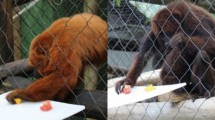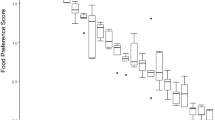Abstract
We assessed the occurrence of food preferences in captive spider monkeys and analyzed whether their preferences correlate with nutrient composition. Using a two-alternative choice test, we repeatedly presented 7 Ateles geoffroyi with all possible binary combinations of 12 types of food that are part of their diet in captivity. They exhibited the following rank order of preference: avocado > sapodilla > pineapple > mango > papaya > melon > banana > apple > tomato > orange > carrot > cucumber. Correlational analyses revealed that this preference ranking is significantly positively correlated with total energy content, irrespective of the source of energy as neither total carbohydrate content nor protein or lipid content is significantly correlated with food preference. Further, food preferences are significantly negatively correlated with water content and positively correlated with the content of magnesium, copper and manganese. These results suggest that despite their high degree of frugivory and high taste sensitivity for soluble carbohydrates, spider monkeys are opportunistic feeders with regard to maximizing net gain of energy.
Similar content being viewed by others
REFERENCES
Barton, R. A., and Whiten, A. (1994). Reducing complex diets to simple rules: Food selection by olive baboons. Behav. Ecol. Sociobiol. 35: 283–293.
Castellanos, H. G., and Chanin, P. (1996). Seasonal differences in food choice and patch preference of long-haired spider monkeys (Ateles belzebuth). In Norconk, M. A., Rosenberger, A. L., and Garber, P. A. (eds.), Adaptive Radiations of Neotropical Primates, Plenum Press, New York, pp. 451–466.
Chapman, C. (1987). Flexibility in the diets of three species of Costa Rican primates. Folia Primatol. 49: 90–105.
Chivers, D. J. (1998). Measuring food intake in wild animals: Primates. Proc. Nutr. Soc. 57: 321–332.
Conklin-Brittain, M. L., Wrangham, R., and Hunt, K. D. (1998). Dietary response of chimpanzees and cercopithecines to seasonal variation in fruit abundance: II. Macronutrients. Int. J. Primatol. 19: 971–998.
Fragaszy, D., Visalberghi, E., and Galloway, A. (1997). Infant tufted capuchin monkeys’ behaviour with novel foods: Opportunism, not selectivity. Anim. Behav. 53: 1337–1343.
Glander, K. E. (1982). The impact of plant seconary compounds on primate feeding behavior. Yearb. Phys. Anthropol. 25: 1–18.
Holland, B., and Welch, A. A. (1992). McCance and Widdowson' The Composition of Foods (5th ed.), Royal Society of Chemists, Letchworth, U.K.
Kinzey, W. G. (1997). Ateles. In Kinzey, W. G. (ed.), New World Primates, Aldine de Gruyter, New York, pp. 192–199.
Knott, C. D. (1998). Changes in orangutan diet, caloric intake and ketones in response to fluctuating fruit availability. Int. J. Primatol. 19: 1061–1079.
Laska, M., Carrera Sanchez, E., and Rodriguez Luna, E. (1996). Gustatory thresholds for foodassociated sugars in the spider monkey (Ateles geoffroyi). Am. J. Primatol. 39: 189–193.
Laska, M., Carrera Sanchez, E., and Rodriguez Luna, E. (1998). Relative taste preferences for food-associated sugars in the spider monkey (Ateles geoffroyi). Primates 39: 91–96.
Laska, M., Hernandez Salazar, L. T., Rodriguez Luna, E., and Hudson, R. (2000). Gustatory responsiveness to food-associated acids in the spider monkey, Ateles geoffroyi. Primates 41: 175–183.
Laska, M., Scheuber, H.-P., Carrera Sanchez, E., and Rodriguez Luna, E. (1999). Taste difference thresholds for sucrose in two species of nonhuman primates. Am. J. Primatol. 48: 153–160.
Menzel, E. W., and Draper, W. A. (1965). Primate selection of food by size: Visible versus invisible rewards. J. Comp. Physiol. Psychol. 59: 231–239.
Milton, K. (1979). Factors influencing leaf choice by howler monkeys: A test of some hypotheses of food selection by generalist herbivores. Amer. Nat. 114: 362–378.
Milton, K. (1981). Food choice and digestive strategies of two sympatric primate species. Amer. Nat. 117: 496–505.
Milton, K. (1998). Physiological ecology of howlers (Alouatta): Energetic and digestive considerations and comparison with the Colobinae. Int. J. Primatol. 19: 513–548.
National Research Council (1978). Nutrient Requirements of Nonhuman Primates. Printing and Publishing Office, National Academy of Sciences, Washington, D.C.
Norton, G. W., Rhine, R. J., Wynn, G. W., and Wynn, R. D. (1987). Baboon diet: A fiveyear study of stability and variability in the plant feeding and habitat of the yellow baboon (Papio cynocephalus) of Mikumi National Park, Tanzania. Folia Primatol. 48: 78–120.
Richard, A. F. (1985). Primate diets: Patterns and principles. In Richard, A. F. (ed.), Primates in Nature, W. H. Freeman, New York, pp. 163–205.
Siegel, S., and Castellan, N. J. (1988). Nonparametric Statistics for the Behavioral Sciences. McGraw Hill, New York.
Souci, S. W., Fachmann, W., and Kraut, H. (1989). Food Composition and Nutrition Tables. Wiss. Verlagsges., Stuttgart.
Stephens, D. W., and Krebs, J. R. (1986). Foraging Theory. Princeton University Press, Princeton.
Van Roosmalen, M. G. M., and Klein, L. L. (1988). The spider monkeys, genus Ateles. In Coimbra-Filho, A. F., and Mittermeier, R. A. (eds.), Ecology and Behavior of Neotropical Primates, Vol. 2, Acad. Brasil. Ciencias, Rio de Janeiro, pp. 455–537.
Visalberghi, E., Valente, M., and Fragaszy, D. (1998). Social context and consumption of unfamiliar foods by capuchin monkeys (Cebus apella) over repeated encounters. Am. J. Primatol. 45: 367–380.
Waterman, P. G. (1984). Food acquisition and processing as a function of plant leaf chemistry. In Chivers, D. J., Wood, B. A., and Bilsborough, A. (eds.), Food Acquisition and Processing in Primates, Plenum Press, New York, pp. 177–211.
Wrangham, R., Conklin-Brittain, N. L., and Hunt, K. D. (1998). Dietary response of chimpanzees and cercopithecines to seasonal variation in fruit abundance: I. Antifeedants. Int. J. Primatol. 19: 949–970.
Author information
Authors and Affiliations
Rights and permissions
About this article
Cite this article
Laska, M., Hernandez Salazar, L.T. & Rodriguez Luna, E. Food Preferences and Nutrient Composition in Captive Spider Monkeys, Ateles geoffroyi. International Journal of Primatology 21, 671–683 (2000). https://doi.org/10.1023/A:1005517421510
Issue Date:
DOI: https://doi.org/10.1023/A:1005517421510




